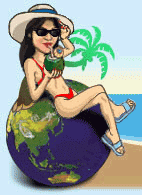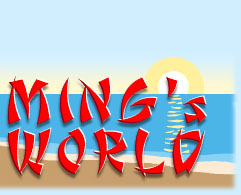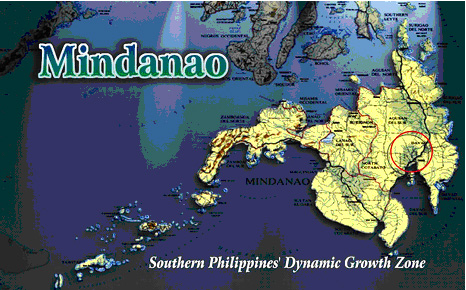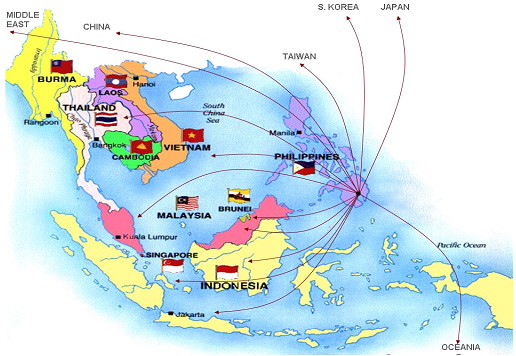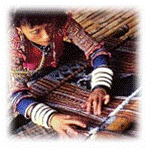
Travel Cheap!
Template design by
|
DAVAOIf you are within the vicinity of Southeast Asia during the months of March or August, drop by Davao City, south of the Philippines.
The bad rap about Davao is that it is in Mindanao – and if you are going to believe all those travel advisories – a place that is rife with insurgency and terrorism. But dispel your misguided fears, Davao City is in fact one of the safest place in the Philippines (average monthly crime volume in 2005 was 11.81 per 100,000 persons).
Davao City is a quick trip from Manila, just 20 minutes shy from two hours, six times a day in two local airlines. You may want to spend some time in Manila while you are there. You can find some great hotels with all the mod cons you get in Britannia Hotels in the UK or there are also beautiful looking ones, like villas in France. Or you may catch direct, twice weekly flights from Singapore, Palau in Micronesia or Manado in Indonesia . And if you are in any of the Philippines’ 7,100-odd islands, you can take connecting flight or a boat ride from Cebu, Zamboanga, Iloilo or Bacolod. But if you fancy a road trip, be prepared to hop from island to island and soak up in the seemingly endless green scenery of the countryside, before arriving to your destination, which is Davao.
A. Paradoxically, Davao
Many find Davao City an interesting paradox. On one hand, it is at the brink of becoming one of Asia’s global cities, consistently making it to the Asian Institute of Management’s most competitive metropolitan cities in the Philippines (from 2002 to 2005). While on the other, the city clings firmly to its cultural traditions, throwing week-long festivities that highlight nature’s abundance, the people’s resilience and its colorful past. March celebrates the city’s foundation day, while August shows gratitude to deities for an abundant harvest.
Then there’s the claim to being one of the world’s biggest cities in terms of land area – measuring at least 2,444 square kilometers. You could be driving for three hours to the west and you would still find yourself well within the boundaries of the city. But the urban sprawl? Much of its business, residential and commercial activities are concentrated on only 10% of its total land area, hugging the shoreline and facing the Davao Gulf.
Life in Davao is unhurried, if not serene; leisurely, if not languid; simple, if not unpretentious. The ritual of unwinding and chilling out starts the moment Friday dusk falls, where most of the city’s nightspots draw throngs of students, yuppies, families and out-of-town visitors enjoying live bands, coffee lattes, scrumptious food, karaoke binges, and a twirl in their dancing shoes.
While the well-heeled and the ueber-rich may find shops that cater to their whims, you will discover that haggling is still a regaled art, particularly in stores that sell crafts, tribal souvenirs and even fresh fruits.
There are hundreds of must-sees in Davao, but if you wander off and got lost, there are always little surprises for the tourists, tucked-away in most unexpected places and interesting faces.
So, in between the superlatives and the mundane, there’s almost anything to enjoy in Davao. Whole year round, actually.
B. What’s Your Agenda?
Hidden no more. Geographically, the city is wedged in the southern-most part of Mindanao island. But this past decade, tourist arrivals continue to rise, ending the year 2005 with high of 573,000 curious and returning tourists.
Helped by its growing reputation as a convention site and the tireless efforts of its local tourism councils, it hosted the ASEAN Tourism Forum just this January 2006. Feted in the usual Davaoeño hospitality, more than 3,000 tour operators and travel agents and those in the hospitality business were whisked from one tourist attraction to another, delighted by a long list of savoury adventures, and immersed in cultural traditions that survived to this day.
Whatever your agenda is, you will find fulfillment during your stay in Davao.
So, if you come –
As a Business Traveler on a Tight Schedule: Chances are, you only have before breakfast and after dinner to savor the sights, sounds, flavors and smells of Davao. If you’re billeted in downtown Davao, you can squeeze in a quick tour of the San Pedro Cathedral, which was originally built in 1847. The Monument of Peace and Unity is just in front of the cathedral. You can pick up souvenirs such as handicrafts, antiques, hand-woven fabrics and other memento at the Aldevinco Shopping Center.
After your business meetings, you can leave your laptop and tie in your hotel room and join the locals for a dinner, drink and little merriment at The Venue, Matina Town Square, Rizal Promenade or the Damosa Gateway. At times, there are bands, cultural presentations and live acts to help you unwind.
And don’t’ fret if you didn’t have time to squeeze in fruit tasting – there are fruit stalls lined up approaching the airport. You can have the sweeter and juicier equivalent of grapefruit – the pomelo in neat little boxes, or whatever fruit is in season (there are always something sweet and succulent through-out the whole year).
As a Pseudo-Anthropologist: The first in your itinerary would be the Davao Museum that holds artifacts, paintings, photographs and snippets of the city’s history. Near the museum are two cultural delights – the TADECO Weaving Center at the Waterfront Insular Hotel and the Nieva’s Arts and Crafts. The former showcases the traditional way of weaving T’nalak cloth and sells finished products that are making waves both in the US and European market. The latter, on the other hand, sells costume jewelry and terracotta jars with ethnic designs.
But the best time to be in Davao is during the Kadayawan Festival, which is marked every third week of August. Started way back in 1988, the festival coincides with the harvest of fruits and the blooming of flowers – setting a perfect background to pay homage to the primeval ethnic people of the region.
Never mind if you are tagged as a shutterbug, but it is best to bring your camera (include extra batteries and bigger storage card) when it is time for you to join the locals in lining-up Davao’s main streets to partake of the street dancing display -- known as the Indak-Indak sa Dalan. Numbering between thirty up to a hundred, garbed in the most colorful ethnic attire, accompanied by stirring drumbeats, different groups re-stage rituals and tales from tribal history. It has become a competition of sorts – the city awards a handsome sum to the best group that comes up with the most mesmerizing and poignant evocation.
A cavalcade of floats festooned in breathtaking arrangement of fresh flowers and fruits continue to amaze not only the tourists, but the locals as well. Kadayawan Festival includes other activities such as the horse fights, indigenous music festival, ethnic-inspired fashion show, street disco party and nightly food party where they close major thoroughfares to put up tents and tables.
The celebration of the Kadayawan is like a call of Pied Piper. Many Davaoenos come home to Davao during this time, where most families, schools and groups schedule their reunions and get-togethers.
As an Epicurean: Freshness and variety – that’s what you’ll get while in Davao.
The city is declared as the fruit basket of the Philippines. Best known for its bananas (literally thousands of hectares, in and around the city), it also grows mango, lanzones, mangosteen, rambutan, pomelo, marang, pineapple, watermelon, and of course, the durian.
Tasting Durian is always a good conversation topic – the uninitiated are always turned-off by its pungent smell and intimidating spikes. The faint-hearted are only lured as far as consuming the fruit in its processed form – be it a filling for a cake, mixed as a confectionary or as strong coffee flavor. But for the durian devotees, the taste of its creamy pulp has no comparison and is best eaten fresh and with hand. During durian season, the city is literally brimming with this infamous fruit (many swear it is an aphrodisiac, but don’t blame Davao’s population on it).
Another famous local ingredient is Tuna, best served raw ala-sashimi style, or grilled over charcoal. And speaking of grilled, there are several local restaurants that serve grilled food – from fresh fish, prawns, mussels, oysters, and the tastier native chicken. Go to Dencio’s, La Parilla, and Jack’s Ridge to enjoy these specialties. And then there’s a line of restaurants along the F. Torres St. such as the Bistro Rosario, Mongolian Barbeque, Harana, Regine’s, Bo’s Café, Kibuwi, Kubyertos and Yanong.
Dotted across the city are restaurants that serve French cuisine such as Claude’s, Japanese such as Tsuru, Thai such as Krua Thai, and Chinese such as Ahfat. Establishments offering Korean and Indian dishes are just starting to get noticed too.
For the best halo-halo, there’s Aling Foping’s; for home-ground coffee brew, there’s Blue Gre; for native delicacies, there’s Jaltan; for home-cooked meals, there’s Nanay Bebeng’s; for lug-lug, there’s Cecil’s. Just ask any Davaoeño what dish is there to taste in the city, and you’ll have enough suggestions to contend with for the next five days.
As a Beach Bum: If you have come to worship the sun and frolic in the sand, you have come to the right place. This is Boracay, minus the crowd. A 10-minute ride in an out-rigger boat brings you across the Davao Gulf to Samal Island. There you can surrender to your wet longings – taking a dip in the clear water or exploring the enchanting depths by scuba diving or just snorkeling. Stretch out on the white sand for that quick tan or flex your muscles by engaging in sailing, water skiing, or windsurfing.
For an excellent accommodation, see for yourself why tourists troop to Pearl Farm Beach Resort. Or, you can rent the Buenavista Island for a day and have an exclusive use of its natural splendor. Otherwise, you can join the locals at the Paradise Island Resort, Costa Marina and Isla Reta.
As a Nature-Lover: The city is blessed by nature. It is practically typhoon-free, sheltered by the mountain ranges. Its soil is rich, supporting hundreds of plantations devoted to fruits, vegetables, cutflowers and other commercial crops.
But Davao City’s claim to fame is its relative proximity to the king of mountains – the Mt. Apo. The highest peak in the country at 3,144 meters, Mt. Apo can be scaled using the Tamayong Trail, which will take the climber about four-days to reach the summit. Along the way, you’ll be treated with waterfalls, lakes, rapids, century old trees, endangered plant and animal species.
Another famous Davaoeño of sort is the Philippines Eagle or the Pithecophaga jefferyi. In the wilds, the eagle feeds on flying lemurs, wild cats, flying squirrels and monkeys (the eagle was formerly known as monkey-eating eagle). It can reach up to one-meter in height, weigh between 4 to 6 kilograms and has wing span of 2 meters. Sadly, you can’t find many of this eagle in Mt. Apo. Fortunately though, you can find 32 (and still growing population) in the Philippine Eagle Center in Malagos, about an hour drive from the city. The Center also provides lectures and guided tours, as well as opportunities to observe the care and breeding of the eagles.
But if you’re not so keen on traveling far, there’s a closer place to commune with nature. A mere 15 minutes ride from the downtown area brings you to the Davao Crocodile Farm. You can observe from safe distance the different life stages of Crocodylus porosus and Crocodylus mindorensis – from eggs to yearlings to full grown adult and then you get the idea why Steve Irwin loves them as much as Salvatorre Ferragamo.
To pump up your adrenalin further, you can take the white water rafting, or go spelunking, or any other outdoor sports that let you soak in Davao’s fresh air.
For a more sedate adventure, you can go to the Eden Nature Park or the Malagos Garden Resort to view their assortment of local orchids (see the regal waling-waling), taste organic vegetables and examine how butterflies metamorphose.
And lastly, there are few incidents of whale shark sighting, crossing the Davao Gulf. Though the frequency is not pronounced, Davaoeños believe it could turn into another tourist attraction soon.
As a Spartan: If you have time and $100 bucks in your back-pocket, what’s the best way to pack memories and your stomach? Davao’s off-beaten tracks, of course. For your quintessential Filipino breakfast fare, you can grab a seat at any of the Tapsilog outlets which serve garlicky fried rice with tapa, tocino, adobo or fifteen others
Or go to the Bankerohan or Agdao public market, and buy yourself from a tremendous assortment of fresh fishes, vegetables and fruits for an spontaneous do-it-yourself meal! There are also several good restaurants that offer buffet meals for as low as P99.
Within downtown area, you can stay in modest but clean hotels, apartelles if you’re with a group, or some other backpacker’s place that’s safe and secure.
To move around, there are public utility jeepneys (you can ask practically anyone for directions), metered taxi and car rentals.
C. Davao’s Past and Her People
Legends had it that the name Davao originated from the old Bagobo word “daba-daba” which meant fire. Fire was important part of the tribal lives, not only for cooking and illumination, but was used for much-revered rituals. Other sources said it could have come from the blending the name of the Davao River, which at that time, was called “Davoh” by the Obos, “Duhwow” or “Davau” by the Guiangans, and “Dabu” by the Tagabawa Bagobos.
Historians also claimed that before the Spanish came to establish Christian settlement in 1847, the tribes of Bagobos, Mandayas, B’laans, Mansakas, Manobos, Atas, Tagacaolos, Guiangans and the Moros peacefully coexisted. Don Jose Uyanguren defeated the then-ruling Moro Chieftain, Datu Bago, and subsequently renaming the region Nueva guipozcoa, in honor of his home in Spain. Uyanguren became Davao’s first governor, though he did not succeeded in developing the area.
After the American forces came in 1900s, slowly, farm ownership grew. Economic activities were invigorated with the expanding transportation and communication facilities. Then in 1903, a Japanese entrepreneur named Kichisaburo Ohta was established vast plantations of abaca and coconut. Japanese plantation workers arrived, creating Japan-kuo or Little Japan in Davao. They had their own school, newspapers, embassy and Shinto Shrine. Their commercial interests expanded to copra, timber, fishing and trading.
In 1937, Davao was inaugurated as a charter city. Thirty years after, it was subdivided into three independent provinces – Davao del Norte, Davao del sur, and Davao Oriental.
D. Some Notes on your Visit to Davao
Bring light clothes when you come to Davao for the temperature never strays between 25-28 degrees, particularly during summer.
And leave your lighters at home, since Davao City strictly prohibits smoking in public place, in government offices and commercial establishments.
If you come during holiday season, Davao City maybe the only city in the country that doesn’t make a sound on the eve of Christmas and New Year’s Day, because firecrackers are banned too.
There are hundreds of thousand green and grey-colored garbage bins scattered across the city. The city is seriously implementing its solid-waste management program, so be warned about throwing anything, anywhere.
Lastly, the city has installed its emergency and rescue system. Just dial 911 and help will be on its way.
So, come to Davao and see what makes the 1.2 million Davaoeños reluctant to leave their home.
http://www.davaotourism.davaoguide.com/
Proceeds
of this websites supports BUGSAY . |


